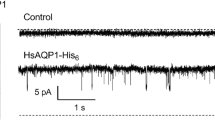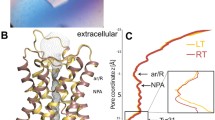Abstract
Permeabilities to glycerol and small non-electrolytes of three Aquaporin 1 CHIP (AQP1) water channels were measured in AQP1 cRNA-injected Xenopus laevis oocytes and in human AQP1 channels reconstituted in proteoliposomes. By an “osmotic” swelling assay, significant increases of ethylene glycol, glycerol and 1,3-propanediol apparent permeability coefficients (P′solutes) were found in oocytes expressing human, rat and frog AQP1. p-Chloromercuribenzene sulphonate (PCMBS) and CuSO4 inhibited, by 95% and 58% respectively, apparent glycerol permeability (P′ gly) in oocytes expressing human AQP1. pCMBS inhibition was reversed by β-mercaptoethanol and CuSO4 inhibition was partly reversed by the Cu2+-binding peptide Gly-Gly-His. Tritiated glycerol uptakes confirmed the augmented P′ gly value of AQP1 cRNA-injected oocytes. In contrast, no increases of urea, meso-erythritol, D- or L-threitol, xylitol and mannitol uptakes were detected. Stopped-flow light scattering experiments performed with human AQP1 proteoliposomes also revealed a much greater increase of P′ gly than did those with protein-free liposomes; the initial rate of proteoliposomes also swelling was inhibited by 96.2% with HgCl2 and by 72.5% with CuSO4. In AQP1 cRNA-injected oocytes and in proteoliposomes, the value of the glycerol reflection coefficient was 0.74–0.80, indicating that water and glycerol share the same pathway. All these results provide strong evidence that water and certain small solutes permeate the AQP1 channels expressed at the surface of X. laevis oocytes or reconstituted in proteoliposomes. The urea exclusion suggests that the selectivity of the AQP1 channels not only depends on the size of the solutes but probably also on their flexibility and their ability to form H-bonds.
Similar content being viewed by others
References
Abrami L, Simon M, Rousselet G, Berthonaud V, Buhler JM, Ripoche P (1994) Sequence and functional expression of an amphibian water channel, FA-CHIP: a new member of the MIP family. Biochim Biophys Acta 1192:147–151
Agre P, Preston GM, Smith BL, Jung JS, Raina S, Moon C, Guggino WB, Nielsen S (1993) Aquaporin CHIP:the arche-typal molecular water channel. Am J Physiol 265:F463-F476
Agre P, Sasaki S, Chrispeels MJ (1993) Aquaporins: a family of water channel proteins. Am J Physiol 265:F461
Bennett V (1983) Proteins involved in membrane-cytoskeleton association in human erythrocytes: spectrin, ankyrin and band3. Methods Enzymol 96:313–325
Bradford MM (1976) A rapid and sensitive method for the quantitation of microgram quantities of protein utilizing the principle of protein dye binding. Anal Biochem 72:248–254
Brindsley N, Wright EM (1976) Effect of temperature on non-electrolyte permeation across the toad urinary bladder. J Membr Biol 29:265–288
Carlsen A, Wieth JO (1976) Glycerol transport in human red cells. Acta Physiol Scand 97:501–513
Carmona A, Freedland RA (1989) Effect of glycerol and dihydroxyacetone on hepatic lipogenesis. Arch Biochem Biophys 271:130–138
Deen PMT, Dempster JA, Wieringa B, Van Os CH (1992) Isolation of a cDNA for rat CHIP28 water channel:high mRNA expression in kidney cortex and inner medulla. Biochem Biophys Res Commun 188:1267–1273
Deen PMT, Verdijk MAJ, Knoers NVAM, Wieringa B, Monnens LAH, Van Os CH, Van Oost BA (1994) Requirement of human renal water channel aquaporin-2 for vasopressin-dependent concentration of urine. Science 264:92–95
Echevarria M, Kuang K, Iserovich P, Li J, Preston GM, Agre P, Fischbarg J (1993) Cultured bovine corneal endothelial cells express CHIP28 water channels Am J Physiol 265: C1349-C1355
Fushimi K, Uchida S, Hara Y, Hirata Y, Marumo F, Sasaki S (1993) Cloning and expression of apical membrane water channel of rat kidney collecting tubule. Nature 361:549–552
Gorin MB, Yancey SB, Cline J, Revel JP, Horwitz J (1984) The major intrinsic protein (MIP) of the bovine lens fiber membrane: characterization and structure based on cDNA cloning. Cell 39:49–59
Heller KB, Lin ECC, Wilson TH (1980) Substrate specificity and transport properties of the glycerol facilitator of Escherichia coli. J Bacteriol 144:274–278
Ishibashi K, Sasaki S, Fushimi K, Uchida S, Kuwahara M, Saito H, Furukawa T, Nakajima K, Yamaguchi Y, Gojobori T, Marumo F (1994) Molecular cloning and expression of a member of the acquaporin family with permeability to glycerol and urea in addition to water expressed at the basolateral membrane of kidney collecting duct. Proc Natl Acad Sci USA 91:6269–6273
Iyer KS, Lau SJ, Laurie SH, Sarkar B (1978) Synthesis of the native copper(II)-transport site of human serum albumin and its copper(II)-binding properties. Biochem J 169:61–69
Jansson T, Powell TL, Illsley NP (1993) Non-electrolyte solute permeabilities of human placental microvillus and basal membranes. J Physiol (Lond) 468:261–274
Kasai M, Kanemasa T, Fukumoto S (1979) Determination of reflection coefficients for various ions and neutral molecules in sarcoplasmic reticulum vesicles through osmotic volume change studied by stopped flow technique. J Membr Biol 51:311–324
Kedem O, Katchalsky A (1958) Thermodynamic analysis of the permeability of biological membranes to non-electrolytes. Biochim Acta 27:229–246
Laemmli UK (1970) Cleavage of structural proteins during the assembly of the head of bacteriophage T4. Nature 227:680–685
Leaf A, Hays RM (1962) Permeability of the isolated toad bladder to solutes and its modification by vasopressin. J Gen Physiol 45:921–932
Levine S, Franki N, Hays R (1973) Effect of phloretin on water and solute movement in the toad bladder. J Clin Invest 52:1435–1442
Levitt DG, Mlekoday HJ (1983) Reflection coefficient and permeability of urea and ethylene glycol in the human red cell membrane. J Gen Physiol 81:239–253
Lowry OH, Rosebrough NJ, Farr AL, Randall RJ (1951) Protein measurement with the Folin phenol-reagent. J Biol Chem 193:265–275
Ma T, Frigeri A, Tsai ST, Verbavatz JM, Verkman AS (1993) Localization and functional analysis of CHIP28k water channels in stably transfected Chinese hamster ovary cells. J Biol Chem 268:22754–22764
Maurel C, Reizer J, Schroeder JI, Chrispeels MJ (1993) The vacuolar membrane protein gamma-TIP creates water specific channels in Xenopus oocytes. EMBO J 12:2241–2247
Muramatsu S, Mizuno T (1989) Nucleotide sequence of the region encompassing the glpKF operon and its upstream region containing a bent DNA sequence of Escherichia coli. Nucleic Acids Res 17:4378
Paganelli CV, Solomon AK (1957) The rate of exchange of tritiated water across the human red cell membrane. J Gen Physiol 41:259–277
Piqueras Somers M, Hammond TG, Strange K, Harris HW Jr, Gawryl M, Zeidel ML (1994) Permeability properties of rat renal lysosomes. Am J Physiol 266:C121-C133
Pratz J, Ripoche P, Corman B (1987) Cholesterol content and water and solute permeabilities of kidney membranes from aging rats. Am J Physiol 253:R8-R14
Preston GM, Agre P (1991) Isolation of the cDNA for erythrocyte integral membrane protein of 28 kilodaltons: member of an ancient channel family. Proc Natl Acad Sci USA 88:11110–11114
Preston GM, Caroll TP, Guggino WB, Agre P (1992) Appearance of water channels in Xenopus oocytes expressing red cell CHIP28 protein. Science 256:385–387
Rigaud JL, Bluzat A, Buschlen S (1983) Incorporation of bacteriorhodopsin into large unilamellar liposomes by reverse phase evaporation. Biochem Biophys Res Commun 111:373–392
Sasaki S, Fushimi K, Saito H, Uchida S, Ishibashi K, Kuwahara M, Ikeuchi T, Inui K, Nakajima K, Watanabe TX, Marumo F (1994) Cloning, characterization, and chromosomal mapping of human aquaporin of collecting duct. J Clin Invest 93:1250–1256
Stein WD (1962) Spontaneous and enzyme-induced dimer formation and its role in membrane permeability. Biochim Biophys Acta 59:35–46
Thiéry JM (1991) VOYONS, programme de simulations conversationnelles en physico-chimie. In:Come GM, Ducloy E, Soulié E, Thiéry JM (eds) Logiciels pour la chimie. Societe Francaise de Chimie, Paris and Association Nat. Logiciel, Nancy, pp 292–293
Toon MR, Solomon AK (1990) Transport parameters in the human red cell membrane:solute-membrane interactions of hydrophilic alcohols and their effect on permeation. Biochim Biophys Acta 1022:57–71
Van Hoek AN, Verkman AS (1992) Functional reconstitution of the isolated erythrocyte water channel CHIP28. J Biol Chem 267:18267–18269
Verkman AS, Ives HE (1986) Water permeability and fluidity of renal basolateral membranes. Am J Physiol 250:F633-F643
You G, Smith CP, Kanai Y, Lee WS, Stelzner M, Hediger MA (1993) Cloning and characterization of the vasopressin-regulated urea transporter. Nature 365:844–847
Zeidel ML, Ambudkar SV, Smith BL, Agre P (1992) Reconstitution of functional water channels in liposomes containing purified red cell CHIP28 protein. Biochemistry 31:7436–7440
Zeidel ML, Nielsen S, Smith BL, Ambudkar SV, Maunsbach AB, Agre P (1994) Ultrastructure, pharmacologic inhibition, and transport selectivity of aquaporin channel-forming integral protein in proteoliposomes. Biochemistry 33:1606–1615
Zhang R, Skach W, Hasegawa H, Van Hoek AN, Verkman AS (1993) Cloning, functional analysis and cell localisation of a kidney proximal tubule water transporter homologous to CHIP28. J Cell Biol 120:359–369
Zhang R, Van Hoek AN, Biwersi J, Verkman AS (1993) A point mutation at cysteine 189 blocks the water permeability of rat kidney water channel CHIP 28K. Biochemsitry 32:2938–2941
Author information
Authors and Affiliations
Rights and permissions
About this article
Cite this article
Abrami, L., Tacnet, F. & Ripoche, P. Evidence for a glycerol pathway through aquaporin 1 (CHIP28) channels. Pflügers Arch 430, 447–458 (1995). https://doi.org/10.1007/BF00373921
Received:
Revised:
Accepted:
Issue Date:
DOI: https://doi.org/10.1007/BF00373921




